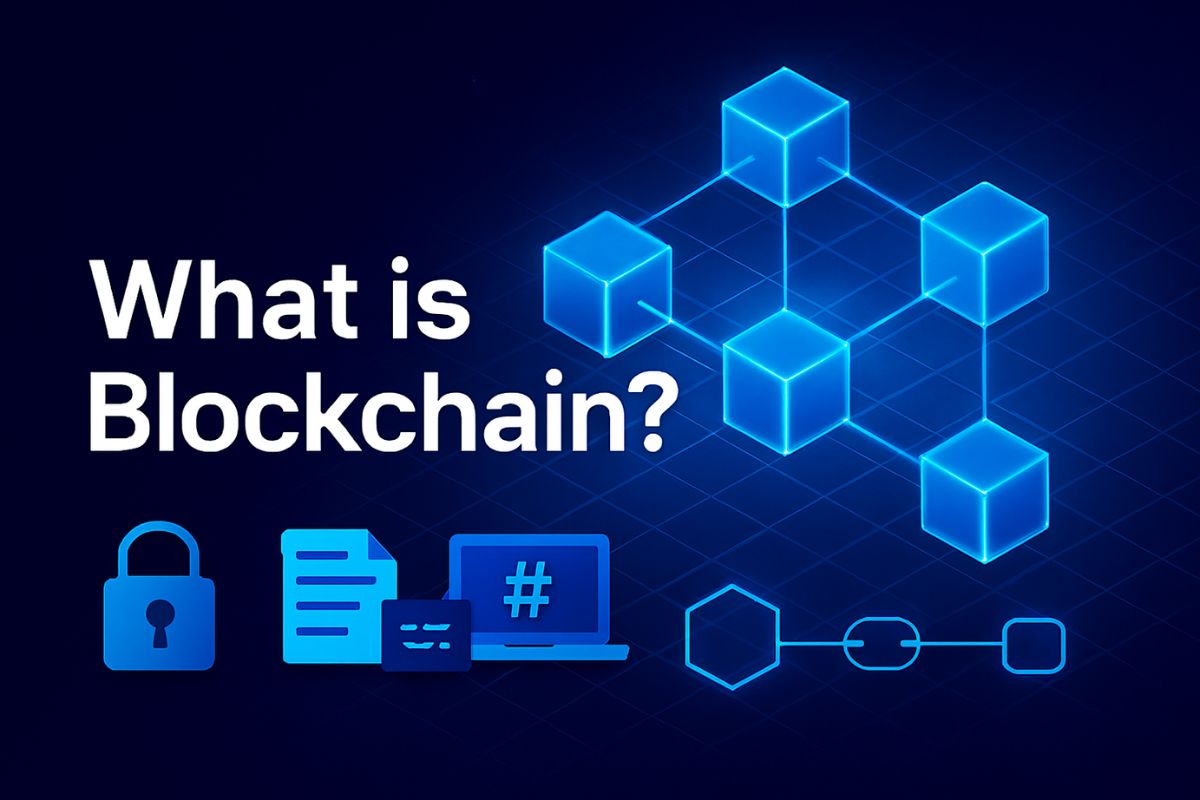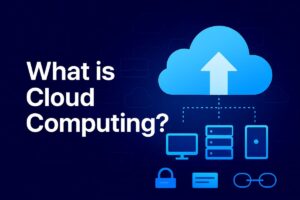Blockchain is a decentralized, tamper-proof digital ledger technology that records data across multiple systems securely. This blog explains how blockchain works, its advantages, types, use cases in India and globally, comparisons with traditional databases, and how students and professionals can start a career in blockchain in 2025.
Heard about cryptocurrency? Bitcoin? NFTs? These innovations are all powered by blockchain—a revolutionary technology that’s reshaping industries worldwide, including in India.
But blockchain isn’t just about crypto. It’s a powerful digital tool that’s improving how we store data, track transactions, and build trust in a world full of digital interactions.
In this guide, you’ll understand what blockchain is, how it works, real-world use cases, the difference between blockchain and traditional databases, and how students or professionals can start building a blockchain career in 2025.
What is Blockchain?
Blockchain is a decentralized, secure, and immutable digital ledger system that records transactions in a chain of blocks—each linked using cryptographic techniques.
This system doesn’t rely on a single server or authority. Instead, data is stored across a peer-to-peer (P2P) network, ensuring that it’s nearly impossible to hack, alter, or delete past records.
How Blockchain Works (Step-by-Step)
- Transaction is initiated — User A sends information to User B.
- Transaction is broadcast — Sent to a network of P2P computers (called nodes).
- Validation process — Network validates the transaction using consensus protocols like Proof-of-Work or Proof-of-Stake.
- Block creation — Validated data is grouped into a block.
- Block added to chain — This block links to the previous one, forming a chain.
- Ledger is updated — All nodes receive a copy of the updated ledger.
Key Features of Blockchain
| Feature | Explanation |
|---|---|
| Decentralization | No central server—data is distributed across the network. |
| Immutability | Once recorded, data cannot be modified. |
| Transparency | Every participant can view and verify data. |
| Security | Cryptography ensures transactions are secure and tamper-proof. |
| Auditability | Historical data is permanently recorded and easily auditable. |
Blockchain vs Traditional Database | Comparison Table
| Feature | Traditional Database | Blockchain |
|---|---|---|
| Control | Centralized (admin control) | Decentralized (network consensus) |
| Data Modification | Editable | Immutable (cannot be changed) |
| Transparency | Limited | High (open visibility) |
| Single Point of Failure | Yes | No (fault tolerant) |
| Speed | Fast | Slower (due to consensus process) |
| Security | Moderate | Very High (cryptographic techniques) |
Types of Blockchains
| Type | Description | Example Use Cases |
|---|---|---|
| Public Blockchain | Open to all; fully decentralized | Bitcoin, Ethereum |
| Private Blockchain | Controlled by one organization | Enterprise supply chain management |
| Consortium Blockchain | Shared control among several organizations | Banking sector, insurance firms |
| Hybrid Blockchain | Mix of public and private features | Government + enterprise use cases |
Real-World Use Cases of Blockchain
In India
- DigiLocker 2.0: Blockchain-powered academic record verification
- YOL (YourOneLife): AICTE & 5IRE verify degrees for 8M+ students
- State Governments: Using blockchain to verify property records and vaccine certificates (e.g., Maharashtra + Polygon)
Globally
- Walmart: Tracks supply chains via Hyperledger
- Estonia: Uses blockchain for digital ID, voting, and health data
- De Beers: Tracks diamond sourcing to prevent conflict gems
Blockchain in Indian Banking & Finance
- BankChain: SBI, ICICI, and HDFC use it for trade finance and KYC
- YES Bank & RBL Bank: Piloted real-time remittances using blockchain
- RBI’s CBDC (Digital Rupee): India’s central bank-backed cryptocurrency, currently in pilot testing
Benefits of Blockchain Technology
For Students & Beginners:
- No need for a tech degree to start
- High-paying careers in development, auditing, and consulting
- Hands-on practice via free tools like Remix and Ganache
For Businesses:
- Eliminate fraud
- Lower operating costs
- Improve transaction transparency
For Government:
- Anti-corruption via tamper-proof records
- Better welfare scheme tracking
- Improved KYC and citizen services
Challenges of Blockchain
| Challenge | Explanation |
|---|---|
| Scalability | Network slows down as users increase |
| Energy Consumption | PoW systems (e.g. Bitcoin) use lots of power |
| Legal Uncertainty | Indian law on crypto/blockchain still evolving |
| Complexity | Hard to integrate into traditional systems |
Career Opportunities in Blockchain (India + Global)
Top Job Roles
- Blockchain Developer
- Smart Contract Engineer
- Blockchain Analyst
- Product Manager (Blockchain)
- Legal/Compliance Consultant
Average Salaries (2025)
| Role | India (₹/year) | Global (USD/year) |
|---|---|---|
| Blockchain Developer | ₹6–15 LPA | $90,000–140,000 |
| Smart Contract Engineer | ₹10–20 LPA | $110,000–150,000 |
| Analyst/Consultant | ₹5–12 LPA | $75,000–100,000 |
How to Start Learning Blockchain in 2025
Step-by-Step Beginner Roadmap
- Learn the Basics – Start with YouTube, blogs (like this), and glossaries
- Understand Key Concepts – Consensus mechanisms, hashing, smart contracts
- Choose a Platform – Ethereum, Polygon, Hyperledger
- Use Developer Tools – Ganache, Truffle, MetaMask, Remix
- Get Certified – via Coursera, Edureka, NPTEL (IITs), or Blockchain Council
- Build Projects – Token system, NFT marketplace, e-KYC, digital voting
- Join the Community – Discord, Reddit, LinkedIn blockchain groups
Blockchain Tools & Learning Platforms
| Tool / Platform | Purpose | Free/Paid |
|---|---|---|
| Remix IDE | Smart contract development | Free |
| Ganache | Local blockchain testing | Free |
| Truffle Suite | Build & deploy Ethereum apps | Free |
| Coursera/NPTEL | Structured courses from IITs | Free + Paid |
| Polygon India | Build dApps on Polygon (India-made) | Free |
Common Misconceptions About Blockchain
- Blockchain = Bitcoin only → Blockchain is much bigger than crypto
- It’s too complex → Learning resources are beginner-friendly today
- Blockchain is illegal in India → No, only unregulated for now
- Only for techies → Roles exist in law, marketing, policy, writing, and operations too
FAQs
1. What is blockchain in simple words?
A blockchain is a digital ledger that records data securely across multiple systems in a decentralized way.
2. How is blockchain different from a traditional database?
Blockchain is immutable, decentralized, and more secure, while databases are editable and centralized.
3. What are smart contracts?
They are self-executing programs that run on the blockchain and automatically perform actions when conditions are met.
4. Is blockchain legal in India?
Yes, blockchain technology is legal. Cryptocurrencies are taxed but not banned. Government projects actively use blockchain.
5. Can I learn blockchain without coding?
Yes, non-tech roles include research, writing, marketing, legal compliance, and product management.
6. What are the best platforms to practice blockchain development?
Remix IDE, Ganache, Truffle, Ethereum testnets, and free learning portals like Coursera/NPTEL.



